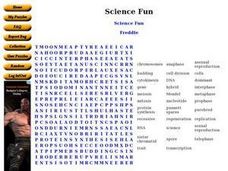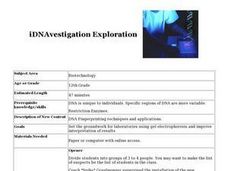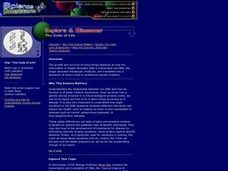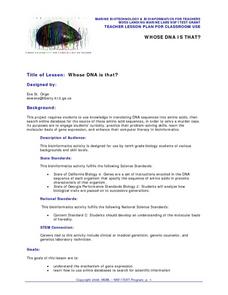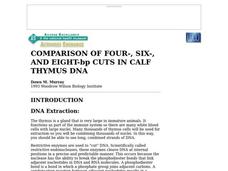Curated OER
Biology Wordsearch
In this biology worksheet, students identify and locate various vocabulary terms found in a biology lesson. There are 39 biology terms located in the word search.
Curated OER
Science Fun
For this biology worksheet, students identify and locate various vocabulary terms related to the cells of the body. There are 32 biology terms located in the word search.
Curated OER
Human Genetics: Yes/No Exercise
For this science worksheet, students demonstrate their knowledge of human genetics by completing a Yes/No exercise. Students read the statement about genes and DNA and agree or disagree with it. No information is given on the page; prior...
Curated OER
Human Genetics Acrostic Poem
In this science worksheet, students demonstrate what they know about DNA and genes by writing acrostic poems. The vertical format is prepared on this page for students. There is no information on the page.
Curated OER
Live Well Now to Live Longer Later
Ninth graders select a topic to research, completing the sentence, "Are the effects of _______ really that detrimental to one's health?" They record information in a journal, including sources of information. Students work in groups with...
Curated OER
Create A DNA Fingerprint
Young scholars engage in a lesson that is about the DNA molecule and focuses upon the sequencing of proteins to identify individuals. They conduct research using a variety of resources and then complete the activities included in the 3...
Curated OER
DNA Recombination II
Students model recombination in DNA. They color the DNA sample and cut it out. Students use their "restriction enzymes" to cut the DNA into specific fragments. They separate the fragments using the "gel electrotrophoresis." Students...
Curated OER
DNA Replication
Students work with a partner to answer any unanswer questions on their review sheet. They work in groups of 4 to make flash cards as study aides. Students play a review game for the remaining of the class period. The winning team...
Curated OER
Cell Structure and DNA
Sixth graders identify, locate and describe the function of the parts of a cell. In groups, they state the five stages of mitosis and put them in the correct order. They are introduced to the structure of DNA and mRNA and how they...
Curated OER
iDNAvestigation Exploration
Pupils investigate DNA Fingerprinting techniques and applications. They participate in a scenario to analyze blood to discover who shattered a plexiglass backboards. In addition, they explain why the DNA fingerprint of blood from the...
Curated OER
Polymerase Chain Reaction and DNA Profiling
Students examine DNA fingerprinting and polymerase chain reaction and how they are used in everyday life and for criminal investigations. They discover how these techniques can also be used to answer ecological and evolutionary questions.
Curated OER
What Do Genes Look Like?
Seventh graders describe the basic structure of the DNA molecule. They identify what an inherited trait is and how it can be determined by one or more genes. Finally, 7th graders identify that plant and animal cells contain several...
Curated OER
The Code of Life
Students study genes, DNA and medical research. They watch "The Code of Life" video and answer discussion questions regarding the transcription and translation of DNA and how errors in these processes and mutations in DNA can produce...
Curated OER
Whose DNA Is That?
Students investigate the use of technology in order to identify different sequences of amino acids by using online web tools. They enhance problem solving skills with amino acid identification skills and strengthening comfort with using...
Curated OER
DNA Isolation
Students use scientific methods to investigate the concept of DNA. They observe the DNA of human cheek cells. This is done with the use of a lab experience. Students record their observations and reflect upon on how each organism is...
Curated OER
Biotechnology
Students analyze the iimpact of biotechnology. They discuss genetically altered foods and the term biotechnology. They research websites and discuss terms related to genes, cells, DNA, and cloning. They write reports to investigate...
Curated OER
Find the Index Case
Students investigate the tracking of viral diseases. They view experiments that compare the genome of the virus known to cause the disease from different areas. Students analyze how these scientists try to figure out the relationships...
Curated OER
Science: Designer genes
Students engineer new organisms using biotechnology. In small groups, they write procedures, list benefits and drawbacks, and explain how their new organism might affect the environment. After creating their new organisms, they present...
Curated OER
DNA Replication
Students construct a 3-D model of DNA. They demonstrate an awareness of base pairs in written work and in a model. Students model DNA replication using edible materials. They record concluding thoughts in their science notebooks.
Curated OER
Extracting DNA
Students explore DNA, genes, chromosomes and the chemicals that make up DNA. They research Internet resources to develop their knowledge of DNA. They conduct an experiment to separate DNA from peas and create a poster that they can use...
Curated OER
DNA-a Molecular Identity
Pupils explore about what DNA is and several different DNA typing techniques. They examine three different situations where DNA typing was used to carry out justice. Students also identify and evaluate different uses of DNA typing...
Curated OER
Build an Electrophoresis Chamber
Young scholars explore electrophoresis, a technique used to isolate DNA. They assemble a gel chamber for separating mixtures. Students observe separation influenced by electric charge. They define separation through gel electrophoresis.
Curated OER
Comparison of Four-, Six-, And Eight-bp Cuts in Calf Thymus Dna
Students investigate the use of restriction enzymes to recognize a four-, six-, and eight-nucleotide sequence. They utilize restrictive endonucleases to cut Thymus DNA and compare results by viewing the DNA fragments on Agarose Gel...
Curated OER
Creative Ways To Teach Evolutionary Concepts
Students explore evolutionary concepts in cartoons and lab activities. They describe and explain evolutionary concepts featured in a cartoon and participate in laboratory activities.



